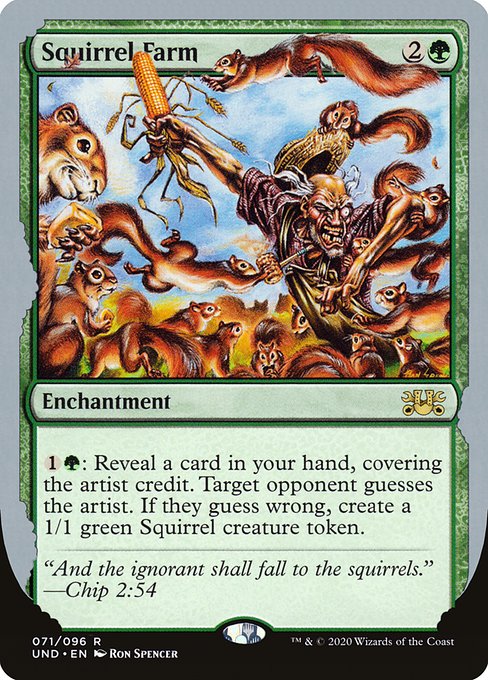
Image courtesy of Scryfall.com
Reprints, Supply, and the Curious Economics of Squirrel Farm
If you’ve spent nights chasing the price graphs as if they were a forest of towering trees, you’ve learned that reprints quietly redraw the landscape. Squirrel Farm, a green enchantment from the whimsical Unsanctioned set, is a perfect little case study. Its {2}{G} mana cost and a clever, puckish ability have made it a fan favorite in casual play, while its rare status and the fact that it’s printed in an offbeat set add a dash of collector charm. The card’s oracle text—{1}{G}: Reveal a card in your hand, covering the artist credit. Target opponent guesses the artist. If they guess wrong, create a 1/1 green Squirrel creature token.—presents a micro-game of bluffing that’s as delightful as it is strategic. And yes, the card is marked as a reprint, which signals a broader print history that can ripple into price behavior 🧙🔥💎⚔️.
In the grand ecosystem of MTG, reprints are the lever that retailers and players watch with caffeinated intensity. When a card like Squirrel Farm shows up in a fresh print run, the immediate effect is usually a bump in supply. More copies on the market can push the floor price downward, especially for a non-foil rarity where production runs are easy to scale. But there’s a tension in play with the card’s enduring appeal. The unsanctioned charm—the quirky mechanic, the cheeky flavor text, and the art by Ron Spencer—sustains demand among collectors and players who relish offbeat nostalgia. That dynamic can keep prices buoyant enough to maintain interest, even as new printings broaden access. The USD price hovering around the tens of cents (here around 0.16 USD) and the EUR price near 0.19 reflect a card that’s accessible, fun, and not chasing a monopoly on value. This is the kind of micro-world where reprints can either dull the sparkle or keep the spark alive, depending on how players hook into its flavor and play pattern 🧙🔥🎲.
Let’s talk mechanics for a moment. Squirrel Farm’s effect is a masterclass in mind games and information asymmetry. For a green deck, the decision to reveal a card in your hand activates a twofold dynamic: you expose information, then you gamble on your opponent’s read of your hand. If they guess the artist incorrectly, you’re rewarded with a 1/1 green Squirrel token—a micro-token engine that scales nicely in multiplayer formats where token swarms can run amok. This dual-layer interaction—bluff and body-creation—gives the card a lasting niche in casual Commander circles and kitchen-table formats where banter and synergy matter as much as raw power ⚔️🎨. Even the lore around the flavor text, “And the ignorant shall fall to the squirrels,” invites players to lean into the whimsy rather than the grind, a reminder that reprints can preserve a card’s identity while broadening its audience 🧙🔥.
From a pricing perspective, reprints don’t merely add copies; they shift perception. A reprint can expand accessibility, making it easier for new players to pick up a deck and experiment with token strategies. In turn, demand in casual and budget-minded circles can stabilize or even grow—especially if the card remains one of the go-to funny uses of green mana in a playful enchantment slot. The fact that Squirrel Farm lives in Und, a set type labeled as “funny,” means the card’s appeal isn’t just about power; it’s about community memory and the shared joke of MTG’s broader culture. When a reprint surfaces, collectors may still seek out the original printing for its historical context, art, or quirky timing, which can keep the card’s value from collapsing entirely. The net effect is a price profile that’s steady, modestly reactive to market winds, and very much a reflection of MTG’s social ecosystem 🧙💎.
“Even a simple bluff can yield a forest of tokens.”
For players and speculators alike, the story of Squirrel Farm isn’t just about numbers; it’s about the lived experience of the game. Reprints shape the price by expanding the pool, but they also remind us why we fell in love with MTG in the first place—the joy of clever interactions, the charm of unusual sets, and the thrill of watching a tiny army of squirrels march onto the battlefield. If you’re chasing the value curve, monitor not only the raw price, but also how often the card resurfaces in new printings and the conversations around it in community spaces. The strategy isn’t just about maximizing a token swarm; it’s about leaning into the card’s personality and using that personality to fuel your board presence, your jokes with friends, and your own deck-building experiments 🧙🔥💎.
As you plan your next deck or your next price-watch session, consider pairing MTG curiosity with real-world utility—like a sturdy desk companion for late-night deckbuilding. If you’re in the market for practical gear that makes your gaming setup feel a little more legendary, take a look at the Phone Desk Stand Portable 2-Piece Smartphone Display. It’s a tasteful nod to the ritual of gathering, drafting, and trading—a small tool that keeps your focus sharp when you’re negotiating prices, discussing metas, or just nerding out with friends after a long play session. See how the everyday object can harmonize with the extraordinary world of magical cards 🧙🔥💎⚔️.
Phone Desk Stand Portable 2-Piece Smartphone DisplayMore from our network
- https://blog.digital-vault.xyz/blog/post/best-mtg-reddit-threads-for-tiger-tribe-hunter/
- https://blog.digital-vault.xyz/blog/post/shield-of-the-avatar-mtg-price-trends-and-collector-value/
- https://blog.digital-vault.xyz/blog/post/the-stone-brain-top-reddit-threads-for-mtg-fans/
- https://blog.digital-vault.xyz/blog/post/white-blue-mana-fixing-for-reliquary-monk-two-color-strategies/
- https://blog.digital-vault.xyz/blog/post/mister-negative-shakes-up-casual-mtg-formats/